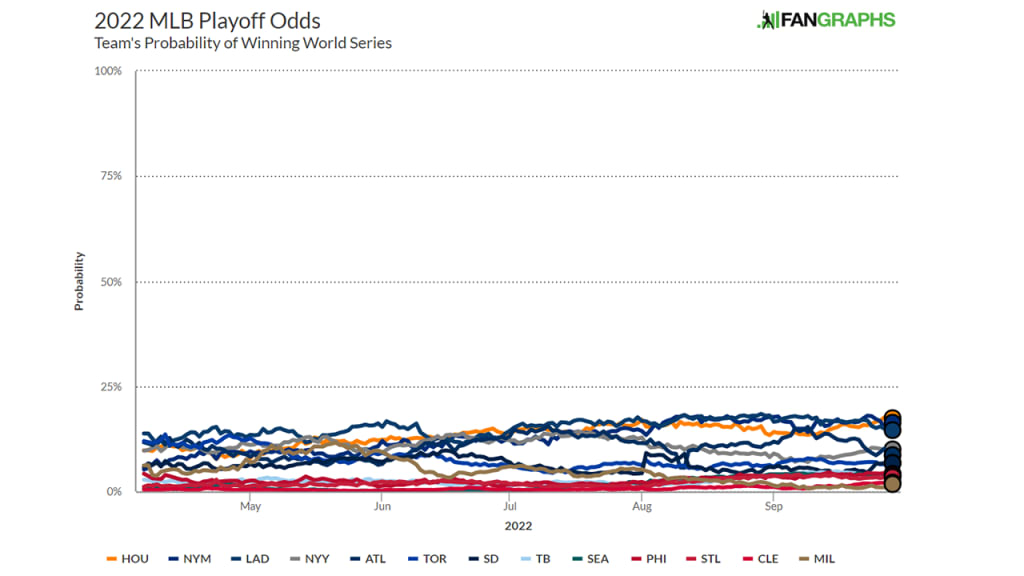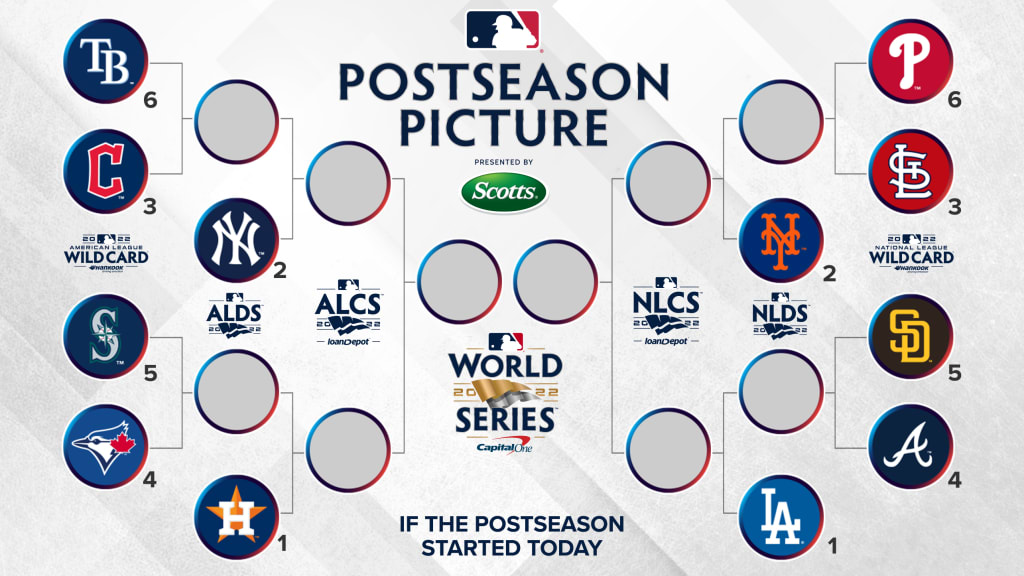This weekend’s Mets vs. Braves series in Atlanta – pending the effects of Hurricane Ian – is without question the biggest regular-season series of the year. There is one game of separation between New York’s 98-58 and Atlanta’s 97-59 records. There are six games left. Three are head-to-head. It doesn’t get much more important than this.
A well-timed head-to-head matchup between the two long-time rivals isn’t just good for drama and entertainment – though it’s that as well. It’s not just about who wins the division, either – though, again, it’s that as well. What’s really at stake here is that it’s going to decide who has to play in the best-of-three Wild Card as the No. 4 seed … and who gets the bye as the No. 2 seed and the right to skip right to the NLDS, where they get to avoid facing the Dodgers. It’s hard to overstate how much this all means.
But it's worth working through what all this means, because this is the first year of this new format. Remember that the Wild Card is best-of-three, all at the home field of the higher seed. And head-to-head matchup is the tiebreaker rather than a Game 163, notable because the Mets hold a 9-7 season advantage over Atlanta and will keep that edge so long as they’re not swept.
Getting the bye matters, probably. But how much? Let's talk about it.
The difference between winning the East and being a Wild Card
Remember, now, there are six playoff teams in each league – three division winners and three Wild Cards. We know that the Dodgers will be the top seed, and the Cardinals will be the third seed. We know that the winner of the Mets/Braves race is locked into the second seed, the loser will be the fourth seed, and the Padres are almost certainly going to be the fifth seed. (The Phillies and Brewers are making it interesting for the sixth and final spot.)
So for the Mets and Braves, it’s less about “division winner” and “Wild Card,” and more about “the No. 2 seed” and “the No. 4 seed.” Think through this with us:
As the No. 2 seed (NL East winner) – five free days of rest, recovery and reset, waiting for the survivor of No. 6 Phillies-or-Brewers vs. No. 3 Cardinals to come to town for a best-of-five NLDS series beginning Tuesday, Oct. 11.
As the No. 4 seed (Wild Card) – exactly one day off before the No. 5 Padres arrive for a Wild Card series beginning Friday, Oct. 7. If they get past that, then their reward is a trip to Los Angeles to face the Dodgers in the NLDS.
So that’s the starting point: It's a harder path, riskier, with more difficult opponents and less chance to set your rotation. That said ...
The odds are against all the playoff teams
There are 12 teams in the postseason under the new format, six from each league. If all 12 teams were evenly talented, and all had the same path to the title, you’d give them an equal 8.3% chance apiece.
Of course, that’s not reality. They are not evenly talented, and also the best four get to skip the Wild Card round entirely. Let’s work through what a bye is worth.
There might be 12 teams, but they don’t have equal paths to the title. It’s really that four teams (the top seeds, who get the byes) have a 12.5% chance – and the eight other teams (the lower seeds, who had to play in the Wild Card round first) each have a 6.25% chance. That's another way of saying “the four winning teams get that 12.5% chance and the four losing teams get a 0% chance, because they have lost.” Again, that’s assuming equal talent, which isn’t the case, but it's a useful starting point.
You can see it in action, though, at FanGraphs’ postseason odds page, which gives you the option to see what happens if you consider every upcoming game to be a 50/50 coin flip – i.e., taking talent out of the equation.
The Astros, Dodgers and Yankees, who have already earned that bye, are right at that 12.5% number to win it all. All the likely Wild Card teams are around that 6.25% number. The Mets (10%) and Braves (8%) are in the middle, reflecting the uncertainty over which one gets the bye. So to take talent out of it, you might say the bye is worth about 6% of World Series odds – the difference between having a 6% shot and a 12% shot.
If that doesn’t sound like a lot, that’s understood. But it’s also the difference between -- when we turn off "coin flip" mode and use real rosters – the Yankees winning it all (10%) and the Phillies doing so (4%). In a postseason scenario where the weakest teams are all off fishing and only the best teams remain to face short, quirky series, it’s impossible for any one club to have overwhelmingly high title chances.

Two evenly matched teams in the NL East
We keep talking about assuming that talent is equal, and how we know that’s not actually true. But since we’re talking specifically about the Mets and Braves, we have one thing working in our favor: they might actually be equally talented.
So if we can agree that they are equally talented, that means the path to postseason success isn’t so much about roster-based differences between the clubs as it is about the different opponents, travel and the challenges faced along the way, based on the outcome of this weekend’s series.
You can see why it should matter. It feels like it should, and it probably does. But by how much? Let’s think through some positives – and a potential negative or two – of getting that division title, and what the odds may not fully capture.
Let’s start with the obvious positives.
1) You can’t lose a series in which you’re not playing.
Well, of course. Take a look at the current playoff bracket, and know that four of the eight Wild Card teams will be home for the winter before the Astros, Yankees, Dodgers and Mets/Braves division champion even need to suit up.
Whichever of the Mets or Braves has to play in the Wild Card series will have, let’s say, something like a 45% chance of their season ending next weekend, given that they’ll be at home. It’s not that hard to see a lesser team toppling a better team in a two-of three. On the other hand, whichever of the Mets or Braves wins the division and gets to wait for the NLDS has a 0% chance of their season ending next weekend.
2) You get to reset your rotation.
This is a big deal for every team, but maybe especially so for a top-heavy rotation like the Mets. If a Wild Card team has to use its top three starters on Friday, Saturday and Sunday (if a Game 3 is necessary), then the choice for Game 1 of the NLDS, on Tuesday, Oct. 11, is either use the Game 1 Wild Card starter on short rest or go with the 4th starter (or a bullpen game).
If you’re the Mets, it’s the difference between starting Jacob deGrom and Max Scherzer in the first two games of the NLDS, or Chris Bassitt and either Taijuan Walker or Carlos Carrasco.
For the Braves, it’s the difference between starting Max Fried and Kyle Wright in the first two games of the NLDS, or Charlie Morton and … well, it’s not clear who their fourth starter is right now. Ideally that’s rookie sensation Spencer Strider, still hopeful to return from an oblique injury. If not, it’s Kyle Muller, or Bryce Elder, or Jake Odorizzi. It’s a huge difference.
3) You don’t have to play the Dodgers right away.
It’s important to remember, here, that the rounds are not reseeded as they progress. It’s a little like the NCAA basketball tournament in that way; you can get the bracket and know exactly what the potential matchups might be.
As you can see in the bracket …

… the winner of that 4 vs 5 series goes directly to Los Angeles. Now, you can put a whole lot of thought into what exactly the Dodgers are right now, because you can simultaneously say “they are baseball’s best team on a run of dominance with no recent precedent” and “how can a team this good have this many pitching questions?” But it’s safe to say they haven’t done what they’ve done by accident, and they’re a very good team you’d prefer not to fly across the country to face.
If you’re the #4 seed – which again, comes down almost entirely to this weekend’s series – and if you beat the Padres, then you get to go to Los Angeles. If you’re the #2 seed, not only do you avoid that fate in the NLDS, you’ve also purchased yourself the possibility that the Dodgers get knocked off in a best-of-5 NLDS anyway.
You can see why you’d like to have the time off. On the other hand, what about if you win the Wild Card?
1) It’s less of a coin flip than it used to be.
By a little, anyway. Literally anything can happen in one game, and has. (Do remember the 2014 AL Wild Card game, where the Royals turned a 7-3 sixth-inning deficit into a 9-8 extra-innings win, or the 2019 NL game, when the Brewers blew a 3-1 lead in part due to Trent Grisham’s error.) A best-of-three set doesn’t change this by nearly enough; it’s a fraction of what you need to get to real talent differences between two good teams. But it’s more than one game, too.
2) The long layoff problem.
The flip side of getting to rest? “Getting too much rest,” depending on what narratives you believe in. This famously was the story for the 2007 Rockies, who had eight days off before the World Series, where they were then swept by Boston. Of course, that’s just one example, and one study looked at nearly 20 years of postseason baseball and found little evidence to support this mattering much.
"Too much rest" is always a convenient excuse, but given the choice, you'd take the time off.
So it all means ...
Ultimately, playoff odds can’t fully answer all the minutiae here, especially in a format we’ve never seen before. But if you remember when we talked about taking the talent out of it by using FanGraphs’ ‘coin flip’ method, giving each team a 50/50 shot, it seemed like the bye was worth about six percentage points of championship odds. If you look at their real, actual talent-based odds, you’ll see that the Mets are at 16% and the Braves at 9%.
That’s mostly because the Mets have the edge to win the division, and thus the bye. It’s the same as the difference between the Dodgers (14%) and the Padres (7%). And that, really, is what the bye is likely to purchase you. It’s a small thing in the grand scheme of things, because there are so many other more important aspects of the playoffs. But the small things add up, too. With rosters frozen, there’s not a single more important thing a team can do right now than to get that bye – which is why both teams will be going all-out this weekend to do exactly that.
